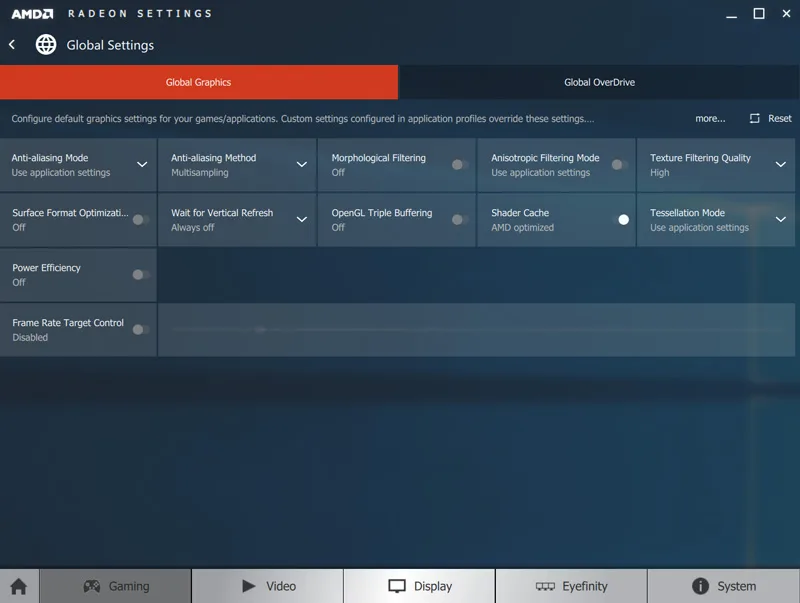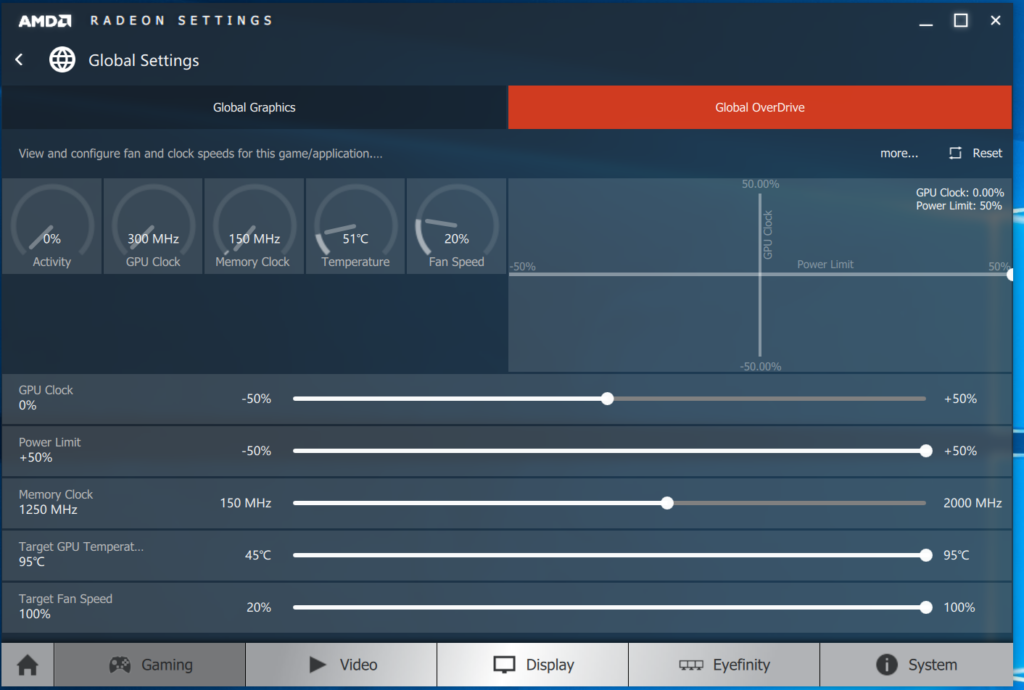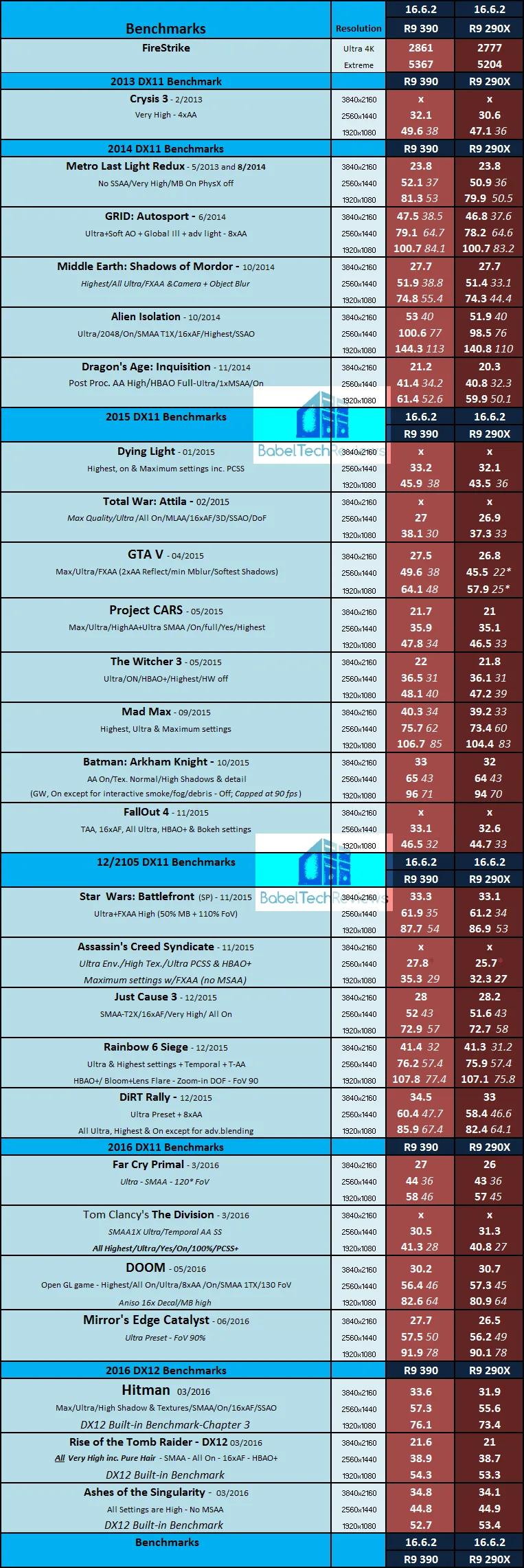This short evaluation will focus on the performance of the 8GB XFX R9 390 Double Dissipation XXX OC Video Card versus the reference 4GB VisionTekR9 290X. It is similar to our September 2015 Evaluation of the MSI Gaming R9 390X OC versus the same 290X which we are able to keep from throttling by increasing the fan speed to 100%. We will also follow the same pattern as our earlier review, and we will also compare with GTX 980 and GTX 970 performance versus these two cards by using 26 games as benchmarks.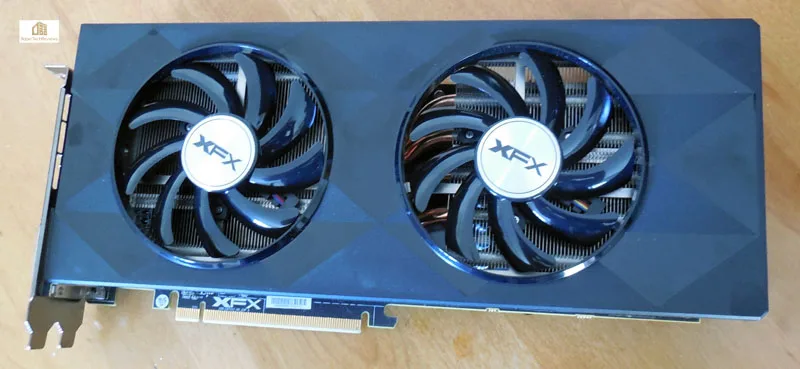
This review compares the mildly factory overclocked XFX R9 390 8GB with the 290X 4GB (non-throttling) reference version. The performance differences between the 390X and the 390, or the 290X and the 290, are minor, probably in the 3% to 7% range. This XFX Double Dissipation XXX OC 390 runs its core/memory clocks at 1015MHz/1500MHz out of the box, +15MHz above reference on the core. We are going to compare with the VisionTek R9 290X which runs at the 290X reference clocks of 1000MHz/1250MHz, which will give the XFX card a very slight advantage with its core clocks of perhaps 2%, and an even larger advantage from its higher memory clocks as we discovered in our 390X vs 290X evaluation.
AMD renamed the usually 4GB vRAM standard equipped R9 290 series “Hawaii” GPU, “Grenada”, and has relaunched it as the 390 series with 8GB of faster memory. The memory frequency is up from 1250MHz (5,000MHz effective) on the 290X to 1500MHz (6,000MHz) on the 390 using higher-specification Hynix GDDR5 memory modules.
Grenada is the same Hawaii GPU released in 2013, but now on a more mature fabrication which allows for higher core clocks – in this case, from 1000MHz on the 290X to 1015MHz on the XFX 390X. Higher core clocks also mean that there is a need for better cooling over the reference design as the voltage has also gone up, and fortunately the XFX card is well up to the task of cooling Grenada effectively.
The Myth of the Throttling Reference 290X & the lack of a proper CrossFire Solution
The 290X reference versions were evidently quite unpopular, originally getting a bad reputation for running hot, and throttling well below AMD’s “up to 1000MHz” on the core when it first launched. We were quite fortunate to originally get a PowerColor PCS+ overclocked reference version of the 290X at launch from retail that is clocked at 1030MHz on the core, and it does not throttle in cool ambient temperatures. In testing our much more recently purchased VisionTek reference version which also pegs 1000MHz, we find it does not throttle either even at stock Uber (55%) fan profile. And neither card throttles at all – either separately, or in CrossFire with a space in between them – when their cooling fans are allowed to spin up to a nearly unbearably noisy 100%.
 Evidently the early Hawaii GPUs at their launch barely met specifications as the reference cooler was unable to cool them properly without throttling the clock speeds. At Hawaii’s launch, AMD was determined to beat the original TITAN’s performance even if it meant running the 290X on the edge with Uber clocks and with uber noise.
Evidently the early Hawaii GPUs at their launch barely met specifications as the reference cooler was unable to cool them properly without throttling the clock speeds. At Hawaii’s launch, AMD was determined to beat the original TITAN’s performance even if it meant running the 290X on the edge with Uber clocks and with uber noise.
Newer Hawaii reference GPUs evidently have no such throttling issues with the reference cooler as long as the gamer is willing to put up with what most consider excessive noise from a fan that spins up to 55% when the GPU hits 94C. This is a rather big issue that CrossFire users face when picking a 290/X video card – either use reference and put up with extreme noise from two cards, or use an open design for multiple cards and roast the interior of your case and the PC hardware inside. Of course, the ideal solution is to watercool two Hawaii or Grenada GPUs, but watercooling is expensive.
 Enter the higher clocked and faster R9 390X and its slightly cut down 390 sibling. AMD has no reference version, so for 390 CrossFire or for 390X CrossFire, this means putting two open-design 390s into a case which may overwhelm its cooling. The 390/X still uses the same GPU as 290/X, but higher clocks now require higher voltage and there is even more heat to deal with. Fortunately, the XFX 390 Double Dissipation XXX OC cooler is able to keep the hot Grenada GPU cool, and it is very effective at idle or at full load. However, at load the card makes itself known, although it is more like a rush of air and not annoying nor intrusive like the hairdryer-like sounds of the original reference 290X at Uber speeds.
Enter the higher clocked and faster R9 390X and its slightly cut down 390 sibling. AMD has no reference version, so for 390 CrossFire or for 390X CrossFire, this means putting two open-design 390s into a case which may overwhelm its cooling. The 390/X still uses the same GPU as 290/X, but higher clocks now require higher voltage and there is even more heat to deal with. Fortunately, the XFX 390 Double Dissipation XXX OC cooler is able to keep the hot Grenada GPU cool, and it is very effective at idle or at full load. However, at load the card makes itself known, although it is more like a rush of air and not annoying nor intrusive like the hairdryer-like sounds of the original reference 290X at Uber speeds.
Grenada has changed nothing from Hawaii except that it has been equipped with 8GB of faster memory with tighter timings, and also with higher core clocks. There are no other changes except to the cooling which is significantly more substantial than the reference version’s cooling.
We shall test 26 games and 1 synthetic test using Core i7-4790K turbo locked to 4.4GHz by the motherboard’s BIOS, ASUS Z97+ motherboard and 16GB of Kingston “Beast” 2133MHz HyperX DDR3 on Windows 10 Home 64-bit:
This evaluation will pit the XFX 390 Double Dissipation XXX OC against the reference 290X, and we will also compare performance with the reference GTX 980 and with the GTX 970 OC. We also use the GTX 980 Ti, R9 Fury X, as well as the GALAX GTX 970 EXOC plus several more cards for a total of 14 video card configurations to give us “The Big Picture”. We are using 26 modern DX11/DX12 games and 1 synthetic benchmark at 1920×1080, 2560×1440, and at 3480×2160 resolutions. We will also look very carefully at our benchmarks to see if a single 390 can benefit from 8GB vRAM over the 4GB of vRAM that the reference 290X is equipped with.
Let’s look over our test configuration on the next page.
Test Configuration – Hardware
- Intel Core i7-4790K (reference 4.0GHz, HyperThreading and Turbo boost is on to 4.4GHz; DX11 CPU graphics), supplied by Intel.
- ASUS Z97-E motherboard (Intel Z97 chipset, latest BIOS, PCIe 3.0 specification, CrossFire/SLI 8x+8x)
- Kingston 16 GB HyperX Beast DDR3 RAM (2×8 GB, dual-channel at 2133MHz, supplied by Kingston)
- XFX R9 390 8GB, Double Dissipation XXX OC Video Card, at XFX clocks (1015/1500MHz) on loan from TechofTomorrow.
- VisionTek R9 290X 4GB, reference clocks tested as single GPU, and also in CrossFire; fan set to 100% to prevent throttling.
- PowerColor R9 290X, 4GB, reference clocks, in CrossFire; fan set to 100% to prevent throttling
- PowerColor R9 Fury X 4GB, at reference clocks.
- GTX 1080, 8GB, Founder’s Edition, reference clocks supplied by Nvidia
- GTX 1070, 8GB Founder’s Edition, reference clocks, supplied by Nvidia
- GeForce GTX 980 Ti, 6GB in SLI and also tested as single GPU, reference clocks, supplied by Nvidia
- EVGA GTX 980 Ti SC, 6GB in SLI and also tested as single GPU, at reference reference clocks, supplied by EVGA
- 2 x GeForce GTX 980, 4GB, reference clocks, in SLI and also tested as single GPU, supplied by Nvidia
- GALAX GTX 970 EXOC 4GB, GALAX factory overclock, supplied by GALAX
- PowerColor R9 280X, 3GB, reference clocks, supplied by PowerColor.
- Two 2TB Toshiba 7200 rpm HDDs
- EVGA 1000G 1000W power supply unit
- Cooler Master 2.0 Seidon, supplied by Cooler Master
- Onboard Realtek Audio
- Genius SP-D150 speakers, supplied by Genius
- Thermaltake Overseer RX-I full tower case, supplied by Thermaltake
- ASUS 12X Blu-ray writer
- Monoprice Crystal Pro 4K
Test Configuration – Software
- The AMD Crimson Software 16.6.2 beta hotfix drivers were used for benching the XFX 390 and the 290X. Other AMD drivers are noted on the Big Picture.
- Nvidia’s GeForce 368.22 WHQL drivers were used for the GTX 980/970, and 368.39 WHQL drivers were used to benchmark the GTX 980 Ti, the GTX 1080 and GTX 1070 with other Nvidia divers used in the Big Picture noted on the chart. High Quality, prefer maximum performance, single display.
- VSync is off in the control panel.
- AA enabled as noted in games; all in-game settings are specified with 16xAF always applied
- All results show average frame rates including minimum frame rates shown in italics on the chart next to the averages in smaller font.
- Highest quality sound (stereo) used in all games.
- Windows 10 64-bit Home edition, all DX11 titles were run under DX11 render paths. Our only DX12 title is run under the DX12 render path. Latest DirectX
- All games are patched to their latest versions at time of publication.
- EVGA’s Precision XOC, reviewer’s version 4 used for Nvidia cards.
The 26 PC Game benchmark suite & 1 synthetic test
- Synthetic
- Firestrike – Basic & Extreme
-
DX11* Games
- Crysis 3
- Metro: Last Light Redux (2014)
- GRID: Autosport
- Middle Earth: Shadows of Mordor
- Alien Isolation
- Dragon’s Age: Inquisition
- Dying Light
- Total War: Attila
- Grand Theft Auto V
- ProjectCARS
- the Witcher 3
- Batman: Arkham Origins
- Mad Max
- Fallout 4
- Star Wars Battlefront
- Assassin’s Creed Syndicate
- Just Cause 3
- Rainbow Six Siege
- DiRT Rally
- Far Cry Primal
- Tom Clancy’s The Division
- DOOM (*OpenGL)
- Mirror’s Edge Catalyst
- DX12 Games
- Ashes of the Singularity
- Hitman
- Rise of the Tomb Raider
AMD Settings
Here are the settings that we always use in AMD’s Crimson Control Center for our default benching. They are identical settings to what we used in the older Catalyst Control Center. The new Power Efficiency Toggle which was recently made available for the Fury X and 300 series cards is left off in our benching. Please note that 100% fan speed is used for benching the 290X reference version, and it does not throttle at all.
The above is our test bench. Let’s check out our performance charts
Performance summary charts & graphs
Here are our results of 26 games and 1 synthetic test. The drivers are noted on the chart. “X” means the benchmark was not run and “NA” means the benchmark could not be run or completed. And an Asterisk (*) means that there are some real issues with the visuals.
All results except for Firestrike are expressed in average fps (in Bold) and also generally in minimum fps (where they make sense, in smaller italics next to the averages). Each set of drivers are compared against the other in the adjoining results column in white (newest driver) versus black (older drivers).
The XFX 390 Double Dissipation XXX OC is generally slightly faster than the reference R9 290X. There are a couple of minor exceptions (DOOM & The Division) which may be explained by drivers. And there are a couple of games which are really benefited by the faster 8GB vRAM on the 390, particularly Assassin’s Creed Syndicate and Grand Theft Auto V. Grand Theft Auto V runs much more smoothly on the 390 8GB than on the 4GB vRAM-equipped 290X, and Assassin’s Creed Syndicate also gains some solid performance over the 290X. Hitman and perhaps even Crysis 3 also appear to run a little faster on the XFX 390 OC that is larger than the usual performance gap over the reference 290X.
As we can see, the performance difference between the reference 290X 4GB and the 390 8GB are generally small, but almost always in favor of the 390.
The Big Picture
The Big Picture, once reserved solely for our video card reviews, has been recently expanded to feature all of our competing top video cards on recent drivers. Driver revisions for each card are noted on the chart. An “X” means the benchmark was not run, while “NA” means the benchmark could not be run or completed. And an Asterisk (*) means that there are some real issues with the visuals. All results except for Firestrike are expressed in average fps (in Bold) and also generally in minimum fps (where they make sense, in smaller italics next to the average results).
For a comparison between competing cards, we moved the GTX 980 in-between the R9 390 and the R9 290X results, and we also added the 970 EXOC results in the fourth column.
Please open this chart in a separate tab or window for better viewing.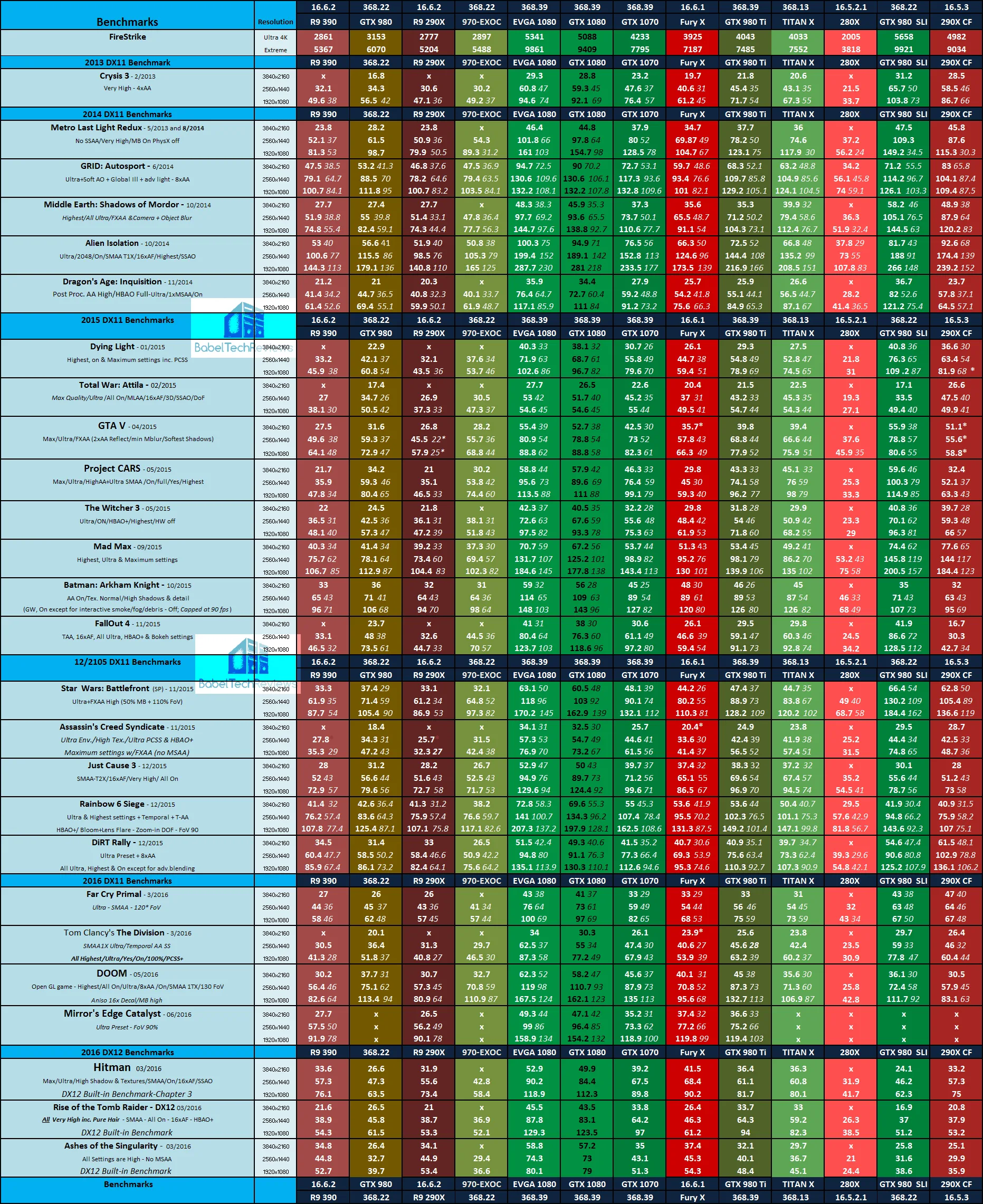
When we compare the XFX 390 8GB card against the GTX 980, it does good at 3840×2160 but trades blows and often loses to the GeForce below 4K resolutions. Neither card is particularly suited for 4K except in multi-GPU configurations in which case the 8GB of video memory will benefit the Radeon. And the 290X trades blows with the GTX 970 EXOC winning in a lot of the newer games.
Let’s head for our conclusion.
The Conclusion
From our original comparison of the 290X with the MSI 390X OC, we found that the newer card is basically an expensive faster aftermarket 290X with double the memory; and there are some 290Xes that have been previously available that were equipped with 8GB of slightly slower vRAM. We were able to clock our 290X to nearly match the performance of the 390X. There is nothing that AMD can do to disguise the fact that Grenada is really Hawaii, and 390X is just an aftermarket overclocked 290X with double the memory. These cards also use a lot of power and generate quite a bit of heat. 
However, as newer games have been released that take advantage of 8GB of vRAM, we see that even the XFX 390 Double Dissipation XXX OC is edging out the performance of the reference 290X, although only slightly overall, especially taking into consideration that the XFX 390 is clocked +15MHz higher on the core than our 290X reference version.
Currently the MSI R9 390 Double Dissipation XXX OC is $249 after $20 rebate at Newegg.com, and it comes bundled with Total War Warhammer. However, we understand that there may be some shortly upcoming changes to AMD’s lineup which may change this picture entirely. In the meantime, we will continue to use our reference (non-throttling) 290X as a test card that can easily stand in for a stock 390 in our benching.
Stay tuned, there is a lot coming from us at BTR. Next up we will evaluate a brand new card next week that you do not want to miss!
Happy Gaming!
Mark Poppin
BTR Editor-in-Chief
